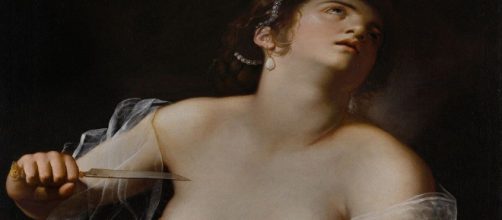There are many unanswered questions about the painting Lucretia by Artemisia Gentileschi, including the latest news that it is now in the collection of the Getty Museum in Los Angeles.
Big mystery
All the L. A Times report said is that on April 5, the Getty “acquired the painting from an undisclosed seller.” The Smithsonian Magazine added to the mystery by noting that the painting “spent centuries hidden from public view” - a reference to all the private collections that held onto it. Mind you, and we’re talking about a picture of a woman committing suicide.
Why would so many private collectors covet such an abhorrent scene? This raises a bigger question. Why did Artemisia paint it in the first place?
Female complaint
Lucretia is identified in history books as a noblewoman in the Roman Empire raped by the son of an Etruscan king who took her own life. Artemisia, herself a rape victim, took her assailant to court, even suffered torture with thumbscrews to make her case. Why would an artist known for picturing heroic women portray a woman who took the easy way out?
I’m thinking of her painting Susannah and the Elders, which describes a woman in her bath rejecting a pair of Peeping Toms’ sexual advances, and her painting Judith and Holofernes, which describes a woman killing an Assyrian general bent on destroying her town.
Both women punished their would-be assailants. Lucretia punished herself.
It’s also notable that the wrong done to Lucrecia is similar to the one done to Susannah. The difference, of course, is that Susannah pushed back against threats, and Lucretia gave in to them. Not only did Artemisia paint Lucretia’s surrender, but she also painted it twice, once in 1623 and once in 1625. The Getty has the latter one.
Out the window
Timothy Potts, Getty Museum director, told the L.A.Times that Artemisia’s painting of Lucretia “will open a window for our visitors onto important issues of injustice, prejudice, and abuse.” Won’t a picture of a woman doing herself in just as likely open a window onto suicide as a way out of injustice, prejudice, and abuse?
David Gasparotto offered a view like that of Potts. In a statement cited by the Smithsonian Magazine, he said that this painting of Lucretia exemplifies Artemisia’s “most significant type of subject, the representation of dynamic female figures in control of their own destiny.” Is he looking at the same painting I am? Lucretia didn’t control anything.
Taking action
I don’t wish to be hard on Lucretia. We all do the best we can. But we don’t expect a painting to celebrate a rape victim’s suicide by an artist who fought against her rapist - her art teacher Agostino Tassi - who was found guilty and banishment from Rome. Isn’t that more like what Gasparotto spoke of: “dynamic female figures in control of their own destiny”?


